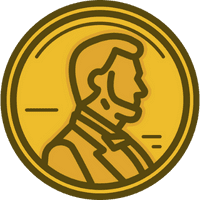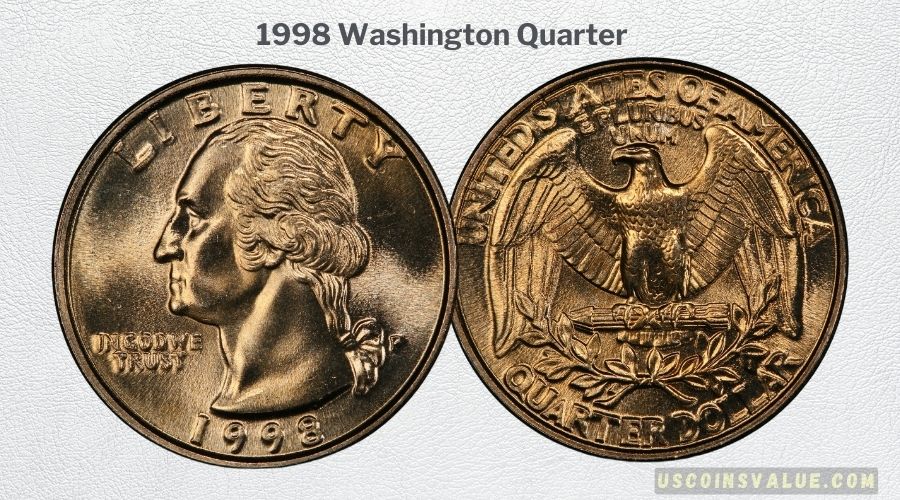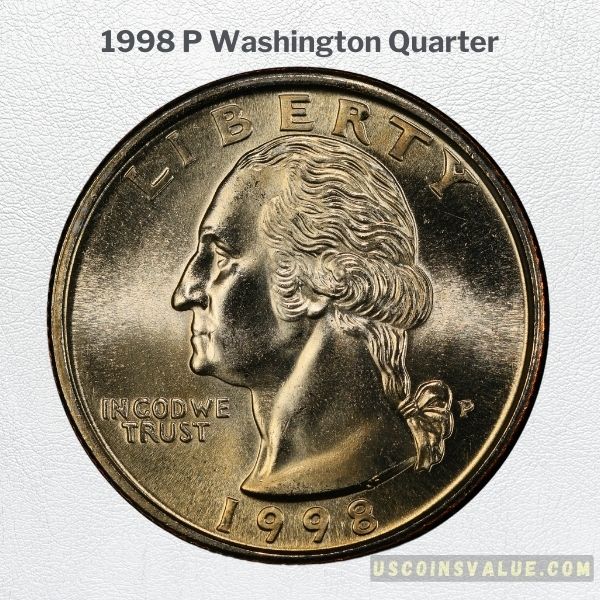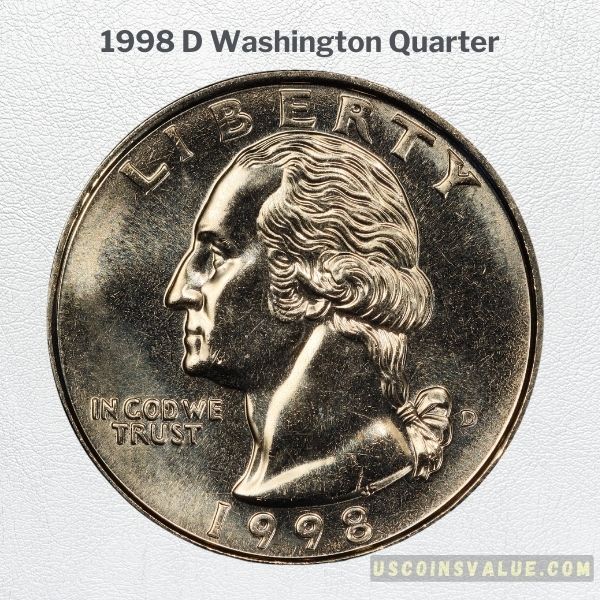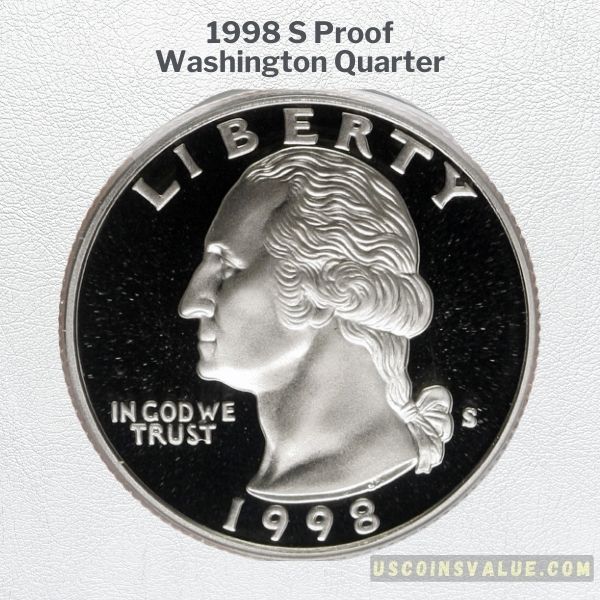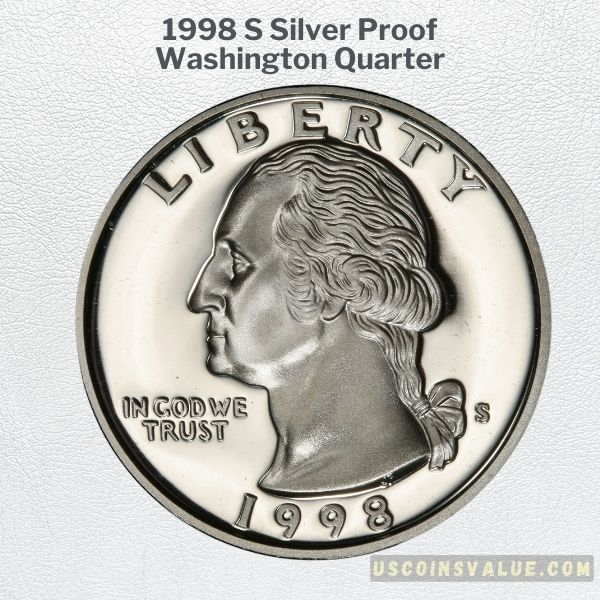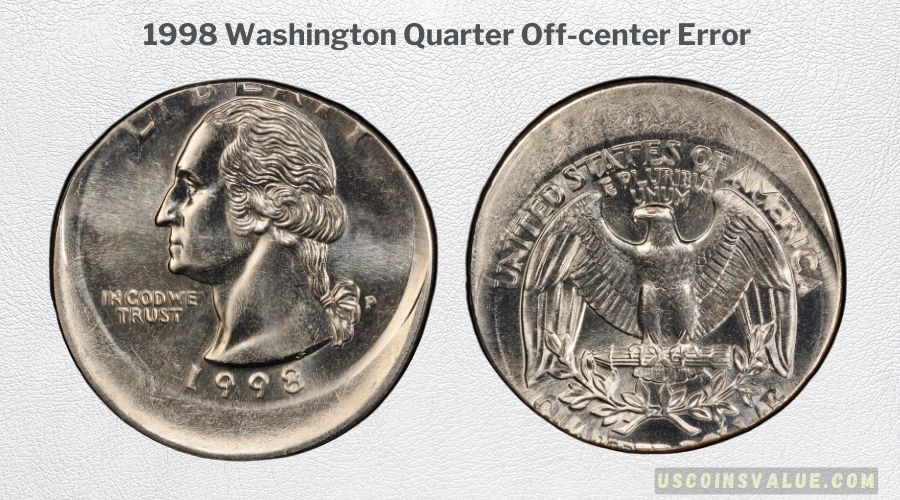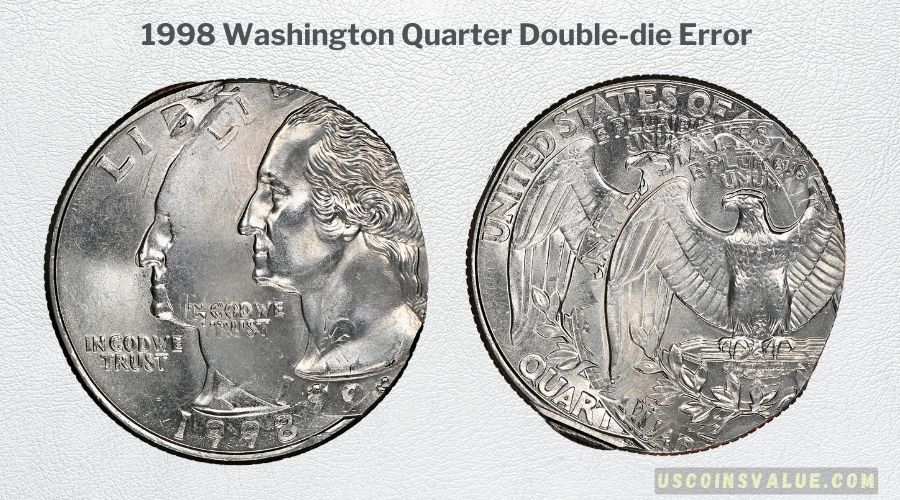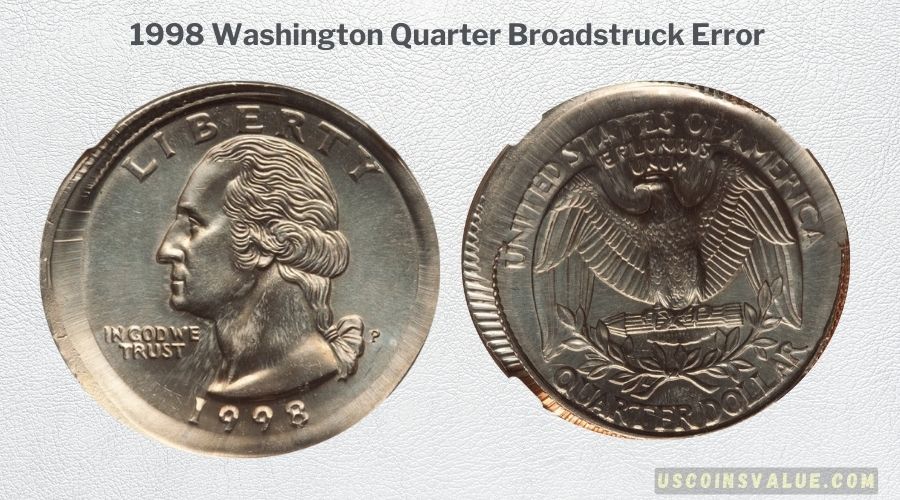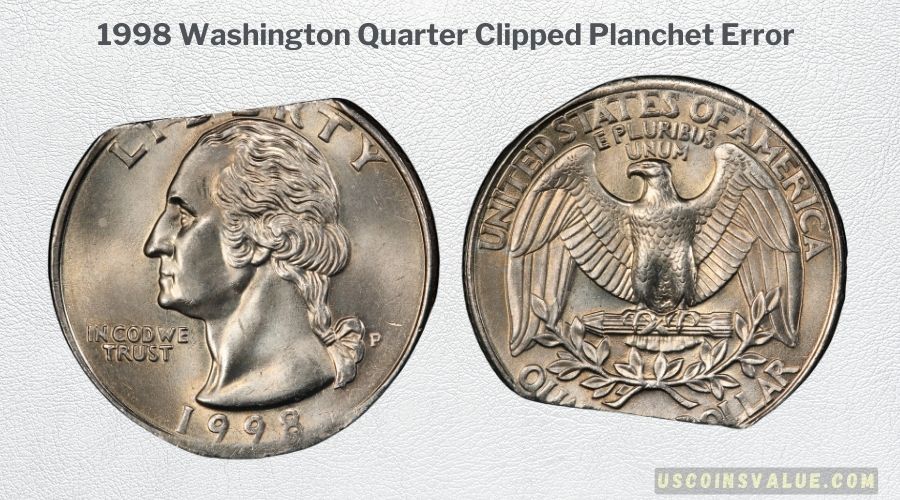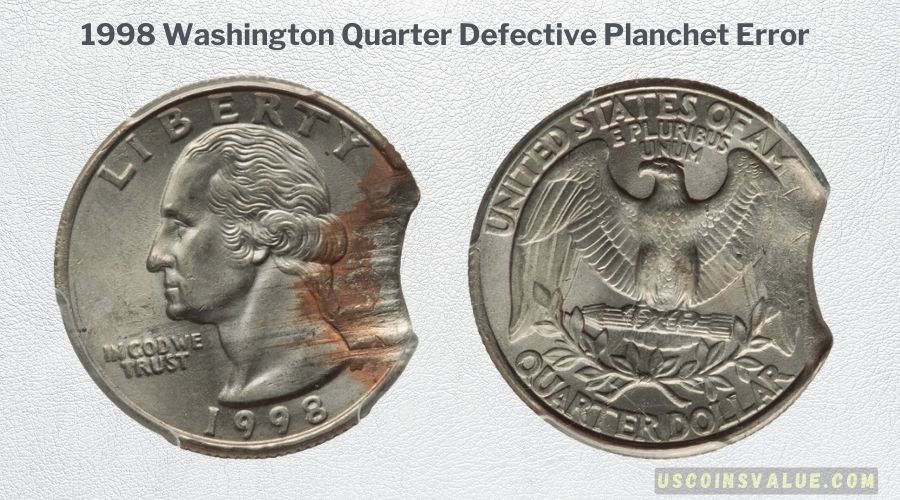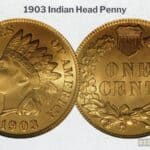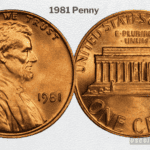The 1998 Quarter belongs to a unique category of American coins that holds a lot of sentimental value. So, if you’ve come across one of these coins and are probably wondering, toss or keep? This guide is for you.
Although, the face value of the 1998 quarter is $0.25, it’s quite possible to find this quarter selling for slightly higher, between $0.30 and $0.85. Additionally, several numismatists are ready to pay as much as $375 when they find one in uncirculated condition.
The best way to make sure you don’t toss out a valuable 1998 quarter is to learn about its value, errors, and varieties of this coin. So, stick around, and let’s unravel all that makes the 1998 Washington Quarter unique.
What is the History of the 1998 Washington Quarter?
Before we discuss the several reasons coin collectors are drawn to this coin, let’s indulge in a little history lesson.
It all began in the early 1930s. As George Washington’s 200th birthday anniversary drew near, Congress sought a way to commemorate this special event. So, they came up with the idea of using the founding father’s portrait on the 25-cent coin.
The design however stuck around far longer than was intended, and subsequent quarters bore George Washington’s portrait, birthing the famous “Washington Quarters”: The 1998 quarter falls in this category.
This cultural significance is one reason why the 1998 Washington Quarters is sought after by both numismatists and coin enthusiasts.
Regardless of the amount of money it may or may not fetch a coin collector, it remains a prized possession as it often reminds people of the rich history of the United States of America.
The 1998 Washington Quarter Features: What Does it Look Like?
1998 quarter specifications:
- Category: Washington Quarters (1932 – 1998)
- Year of Make: 1998
- Mint Branch: Philadelphia, Denver, San Francisco
- Composition: 67% copper, 8.33% nickel & 90% Silver, 10% Copper.
- Weight: 5.67 grams
- Diameter: 24.26 millimeters
- Thickness: 1.75 millimeters (0.069 inches)
- Edge: Reeded
What are the 1998 Quarter Varieties?
Like most Washington Quarters, quarters from 1998 were minted in different locations across the U.S as coins were usually struck at the Denver, Philadelphia, or San Francisco Mint. In addition to this, it’s also crucial you know that there are regular strike varieties and two proof varieties.
1998 Quarters bear either “D,” “P,” or “S” mint mark. This signifies the mint facility responsible for the mintage. With a total of 1,720,233,299 coins minted, the 1998 Quarter exists in the following varieties;
| 1998 (Washington) Quarter Varieties | Composition | Mint Location | Mintage |
| 1998-P (Regular Strike) | 75% copper and 25% nickel over a pure copper center | Philadelphia | 896,268,000 |
| 1998-D (Regular Strike) | 75% copper and 25% nickel over a pure copper center | Denver | 821,000,000 |
| 1998-S (Proof Strike) | 75% copper and 25% nickel over a pure copper center | San Francisco | 2,086,507 |
| 1998-S Silver (Proof Strike) | 90% silver and 10% copper | San Francisco | 878,792 |
1998 Quarter Obverse & Reverse Design
In a manner similar to other Washington Quarters before it, the 1998 Quarter maintained John Flanagan’s 1932 design.
The obverse (head) of this quarter holds a bust of George Washington facing the left.
N.B: A coin without any errors would typically have this portrait right at its center, but coins with the off-center error usually have the portrait leaning away from the center (more on errors later).
Asides the centered portrait of Washington, there are also a number of inscriptions;
- LIBERTY: At the top of the coin, towards its rim.
- IN GOD WE TRUST: On the left of the coin, in front of George Washington’s bust.
- MINT MARK: Depending on its mint, either “D”, “S”, or “P” beside the bow of George Washington’s bust.
- 1998: At the bottom rim of the coin, below the ex-president’s bust.
The reverse (tail) of the 1998 quarter features one of the most popular national symbols in America: the bald eagle.
The majestic bird appears in the center of the coin with its wings outspread, while its claws hold onto a bunch of arrows. Just underneath this image is a bunch of olive branches. The coin also features the following inscriptions;
- UNITED STATES OF AMERICA: At the upper rim of the coin.
- E PLURIBUS UNUM: At the upper middle area of the coin above the bald eagle’s head.
- QUARTER DOLLAR: Below the bunch of olive branches at the bottom of the coin.
What Makes the 1998 Washington Quarter Special?
Although it’s easy for you to lump this coin in the same category as other Washington quarters, the 1998 quarter holds a special place in the heart of collectors for a couple of reasons. One of which is the year after 1998, the Tooltip Public Law introduced the famous 50 States Quarters Program in 1999.
This program was a 10-year commemorative initiative that essentially honored the 50 states in America.
The introduction of this program led to a significant change in the design of the quarters succeeding the 1998 Washington quarters. They retired the heraldic bald eagle and an image that honored each state took its place.
Hence, the 1998 Washington Quarter was the last coin at the time to feature the bald eagle. Although this quarter did not make it to the Statehood Quarters series, it is still revered as it marks the end of an era in American numismatics.
The 1998 Quarter Value: How Much is it Worth Today?
If you find a 1998 Washington Quarter in circulated, worn condition, it should be worth its face value of $0.25 and a melt value of $0.0513.
As of September 2023, the NGC Price Guide estimates the value of one of these quarters to fall between $0.30 and $0.85, but if you find one in great, uncirculated condition, it can sell for as high as $375.
This summary chart gives a clearer picture of what your 1998 Quarter can sell for in today’s market.
| 1998 Quarter Grade | 1998-D (M.S) | 1998-P (M.S) | 1998-S Proof (P.R) | 1998-S Silver Proof (P.R) |
| 61 | $2.50 – $3 | $2.50 – $3 | $8 | $5 |
| 62 | $3.50 – $4 | $3.50 – $4 | $9 | $5.10 |
| 63 | $5 – $6 | $5 – $6 | $11 | $10.50 |
| 64 | $7.50 – $8.50 | $7.50 – $8.50 | $12 | $11 |
| 65 | $10 | $10 | $13 | $12 |
| 66 | $37.50 | $15 | $14 | $13 |
| 67 | $100 | $55 | $17 | $14 |
| 68 | N/A | $375 | $20 | $16.25 |
| 69 | N/A | N/A | $26.25 | $25 |
| 70 | N/A | N/A | $45 | $65 |
1. 1998 P Quarter Value
With over 890 million 1998 Quarters produced from the Philadelphia mint, this is one of the most common coins you can find.
Because this coin is still in high circulation, you can buy a circulated, worn piece at $0.25, with a melt value of $0.0513. However, a 1998-P Quarter uncirculated mint condition can sell for $8.07 or more.
According to the most recent updates on the NGC Price Guide, a 1998-P Quarter between grade PrAg and MS59+ is valued between $0.30 and $0.85 but can go for $375 in higher mint state condition.
Recently, a 1998-P Quarter sold for $103 in 2022, however, the highest recorded sale was $1,380 in 2007. The table below shows some other high auction records for this quarter.
| Grade | Highest Price & Sale Date | Firm |
| MS68 | $368 (2014) | Heritage Auctions |
| MS68 | $329 (2014) | Heritage Auctions |
| MS64 | $299 (2004) | Heritage Auctions |
| MS68 | $217 (2014) | Heritage Auctions |
| MS68 | $204 (2018) | Heritage Auctions |
2. 1998 D Quarter Value
The Denver mint produced about 821 million 1998 Quarters, making it so abundant you may often find it in pocket change. When it comes to coins, the rarer they are, the more valuable. As such, the abundance of the 1998 Quarter makes it less valuable than other low-mintage coins.
On average, the 1998-D Quarter is valued between $0.30 and $0.85. 1998-D Quarters found in pristine condition of grade MS67 can sell for up to $100.
The most recent sale recorded for a 1998-D Quarter was in August 2022, where a grade MS66 sold for $41. However, the highest recorded sale stands at $1,528 by Heritage auctions in 2015.
Let’s take a look at some other high auction prices for this coin variety;
| Grade | Highest Price & Sale Date | Firm |
| MS67 | $920 (2007) | Heritage Auctions |
| MS67 | $748 (2010) | Heritage Auctions |
| MS67 | $626 (2007) | Heritage Auctions |
| MS67 | $364 (2014) | Heritage Auctions |
| MS67 | $288 (2011) | Great Collections |
3. 1998-S Proof Quarter Value
The San Francisco Mint produced about 2 million clad-proof quarters. The proof coins were made specially for coin collectors, possessed superior furnishings compared to the D and P varieties, and had appealing exteriors.
Although you’d expect a coin with such a low mintage to attract higher prices, that is not the case. The lowest grade of a 1998-S Proof Quarter (PF60) is valued at $4.90, while a grade of PF70 is valued at $45. The USACoinbook estimates the value of a grade PR65 to be $6.81.
The profit from this coin may be worth little compared to other coins, but it still makes a beautiful addition to your coin collection. As such, Some 1998-S Proof Quarters have sold for more than the prices indicated above.
In January 2023, a 1998-S Proof Quarter sold for $19, but according to PCGS, the most expensive sale was made in August 2014 when a 1998-S PR65 grade Washington quarter sold for $9,988. The table below shows some other high auction prices for this quarter.
| Grade | Highest Price and Sale Date | Firm |
| PR62 | $7,638 (2014) | Heritage Auctions |
| PR70 | $219 (2005) | Heritage Auctions |
| PR70 | $173 (2007) | Heritage Auctions |
| PR70 | $127 (2007) | Heritage Auctions |
| PR70 | $109 (2006) | Heritage Auctions |
4. 1998-S Silver Proof Quarter Value
Besides regular 1998-S S Proof Quarters, the San Francisco Mint also produced about 800 million Silver Proof Quarters, made of 90% silver.
The composition of these coins made them slightly more valuable, but they do not usually attract thousands of dollars as you’d expect. They are valued at an average of $13, with a melt value of $4.0474.
According to the NGC Price Guide, the lowest known grade of a 1998-S Silver Proof Quarter is PF60, valued at $4.90. At grade PF70, one of these could go for $65.
Interestingly the auction record and highest recent price for this 1998-S silver proof quarter coincides as in May 2021 it sold for $930.
Take a look at other high auction prices for the 1998-S Silver Proof Quarter.
| Grade | Highest Price & Sale Date | Firm |
| PR70 | $403 (2005) | Heritage Auctions |
| PR70 | $288 (2006) | Heritage Auctions |
| PR70 | $196 (2006) | Heritage Auctions |
| PR70 | $173 (2007) | Heritage Auctions |
| PR70 | $161 (2007) | Heritage Auctions |
1998 Quarter Error List
Faulty minting equipment produces imperfect quarters with noticeable errors. These errors usually place a quarter at a higher value than its face value.
The 1998 Quarter exists in some error varieties that you might consider valuable. Let’s discuss some of these unique errors.
1. Off-center Error
The off-center error occurs when a coin is not struck in the middle as intended. It results in a quarter that has its design tilting away from the center in various percentages. An error coin in this category could be between 10% and 90% off-center.
One of the highest prices a 1998 Off-center quarter cold for was $180 in October 2021. As such, if you have an error coin in this category, you can expect to sell it for a couple hundred dollars. Here are other off-center error coins that have sold for similar prices;
- 1998-P 25c Washington Quarter Dollar – Struck 15% Off Center: This was graded MS66 and it sold for $67 in October 2022.
- 1998-D 25c Washington Quarter Dollar – Struck 75% Off Center: Sold for $139 in 2022.
- 1998 25c Washington Quarter Dollar – Struck 50% Off Center: This is also a mint error coin that lacks any visible mint mark. It sold for $74 in 2010.
2. Double-die Error
A 1998 Double-die error coin is a fairly common coin. This error occurs when a coin is struck more than once with the same die.
Coins can not only be double-struck; they can also be triple and quadruple-struck with the same die. However, this is a rare occurrence, and coins with higher double strikes often attract higher prices.
For instance, a 1998 25c Washington Quarter – Quadruple Struck sold for $1140 in October 2021. Do you think you might have one of these in your possession? Take a look at some other similar error coins and how much they were valued for;
- 1998-P 25c Washington Quarter Dollar – Triple Struck: Graded MS67, this quarter sold for $1,080 in October 2021.
- 1998-P 25c Washington Quarter Dollar – Double Strike, Second Strike Off Center: This 1998-P Quarter Double Die coin was graded MS65 and sold for $960 in 2021 because it also had an off-center double strike.
- 1998-P 25c Washington Quarter Dollar – Double Strike, Second Strike Off Center: This quarter sold for $840 in October 2021.
3. Broadstruck Error
In the process of minting, the collar of a planchet might get loose or improperly placed. This results in a coin that gets struck outside its collar, allowing its diameter to be larger than usual.
Broadstruck coins and off-center error coins are quite similar as they both have coins being struck outside the retaining collar. However, broadstruck coins retain their complete design, including the rim and denticles.
Here’s an example of a 1998 quarter with this error;
- The 1998-P 25c Washington Quarter Dollar – Broadstruck: This sold for $164 in April 2022.
4. Clipped Planchet Error
If your quarter looks like someone has taken a bite out of it, it’s the result of a clipped planchet error.
This error occurs when the planchet misaligns with the cutting device during the minting process, thereby creating imperfect cuts.
The clipped planchet error coin features a straight edge instead of a curved one. It remains one of the most fascinating error coins you can come across.
Take a look at a 1998 Quarter that exhibits this error ;
- 1998-P 25c Washington Quarter Dollar – Straight End Clipped Planchet: Graded MS65 and sold for $69 in August 2022.
5. Defective Planchet Error
Planchets are not always perfect and can develop some defects during the minting process. If the error created by the defective planchet is dramatic, it can fetch hundreds of dollars, depending on the severity.
Here’s an example of a 1998 quarter with this error;
- 1998 25c Washington Quarter – Struck on 10% Defective Planchet: Sold for $156 in 2021 at grade MS64.
Final Thoughts
If you’re looking to make thousands of dollars from selling a rare coin, the 1998 Washington Quarter may not be the best place to look. This is because the coin was produced in high numbers and has only a few desirable errors.
On the other hand, if you’re looking to add a shiny, attractive coin to your collection, the 1998- S Proof or Silver Proof Quarters were carefully made, and they’d make your coin collection even more shiny.
